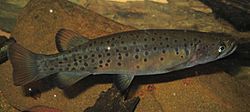Spotted galaxias facts for kids
Quick facts for kids Spotted galaxias |
|
|---|---|
 |
|
| Spotted galaxias. The characteristic base colouration and black edges to the fins are not particularly noticeable in this photo | |
| Scientific classification | |
| Kingdom: | |
| Phylum: | |
| Class: | |
| Order: |
Osmeriformes
|
| Family: | |
| Subfamily: | |
| Genus: |
Galaxias
|
| Species: |
G. truttaceus
|
| Binomial name | |
| Galaxias truttaceus Valenciennes, 1846
|
|
The Spotted Galaxias (Galaxias truttaceus) is a beautiful fish that lives mostly in fresh water. You can find it in southern Australia. Many people think it's one of the prettiest fish in Australia.
It has a long, round body with a brownish-red color. It's covered in dark, ringed spots. Its dorsal, anal, and pelvic fins have cool black edges. There's also a dark stripe that goes across its eye.
Spotted Galaxias live in many places. You can find them in southern Victoria, all over Tasmania, and on islands between these two places. They also live in the southwest part of Western Australia.
On the mainland, these fish usually live in rivers near the coast. When they are babies (larvae), they get carried out to sea. Later, as young fish, they swim back into fresh water. In Tasmania, they mostly live in coastal rivers too. But some groups of Spotted Galaxias live only in freshwater lakes and never go to the sea.
People once thought Spotted Galaxias were not native to the Murray-Darling river system. However, old records from the 1850s suggest they did live there a long time ago. This means that fish found there today might actually be native, not just moved there by accident from projects like the Snowy Mountains Scheme.
Contents
Where Spotted Galaxias Live and What They Eat
Young and adult Spotted Galaxias live in coastal rivers. They prefer cool rivers that flow through forests. These rivers usually have very clean water and lots of places to hide. They like areas with big rocks, sunken logs, and banks that hang over the water.
Spotted Galaxias are hunters. They like to eat small creatures that float by in the river currents. Their diet is mostly made up of insects and other small animals that live in the water or fall into it from the land.
Reproduction and Life Cycle
Spotted Galaxias lay their eggs in rivers during winter. After the eggs hatch, the tiny baby fish (larvae) are carried out to sea. Later, as they grow into young fish, they swim back up the rivers. These young fish look different from the adults at first.
Sometimes, people used to catch these young fish as "whitebait" for food. This led to too many being caught in the past. Fish that live only in lakes lay their eggs in spring.
Spotted Galaxias and People
Long ago, before other types of fish like trout were brought to Australia, people loved to fish for Spotted Galaxias. They used special fly-fishing gear. Anglers liked them because they were beautiful and would bite both wet and dry flies. They were also fun to catch on light fishing lines because they put up a good fight.
Spotted Galaxias could grow quite large for a galaxias, sometimes up to 30 centimeters (about 12 inches) long, and often 20 centimeters (about 8 inches). It seems they were even bigger on average before trout were introduced. Today, a few fly-fishers are rediscovering how much fun it is to fish for this amazing native fish using very light gear.
As mentioned, the young fish swimming back to the rivers were, and sometimes still are, caught as whitebait for people to eat.
Because they are so pretty, Spotted Galaxias could also be kept as pet fish in aquariums. But they need cool water to stay healthy.
Protecting Spotted Galaxias
Spotted Galaxias face several dangers. Dams and weirs (small dams) block their way, stopping them from moving up and down rivers. This breaks up their homes. Bad forestry and farming practices can also harm rivers by making the water muddy or dirty.
Another big problem is competition and being eaten by trout. Trout are not native to Australia and cause serious issues for many Australian fish.
In Tasmanian rivers, there are far fewer Spotted Galaxias when trout are around. This is a common problem. Galaxias species that manage to survive with trout (many don't) are forced to find less ideal places to feed. They might have to eat different foods or feed at different times because trout are more aggressive. This can make the galaxias grow slower, stay smaller, and have fewer babies. This worries scientists about their future.
In southern Victoria, many fishermen say that Spotted Galaxias are only found in the few streams where there are no trout. In these trout-free streams, Spotted Galaxias seem to grow even bigger than they do in Tasmania. It's a big concern that there aren't enough places free of trout for Spotted Galaxias and other native fish in southeastern Australia.

